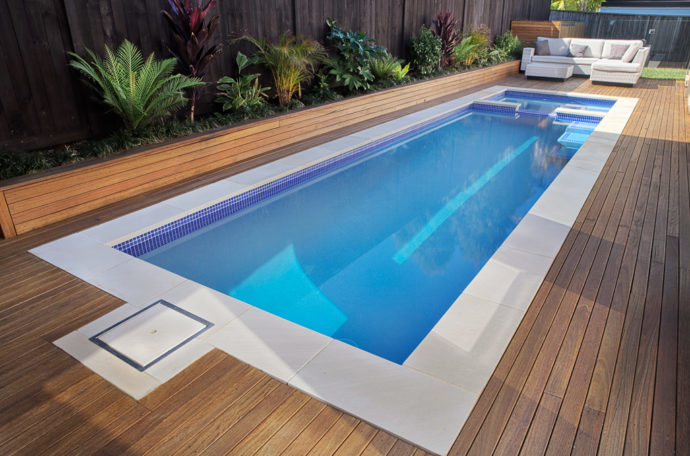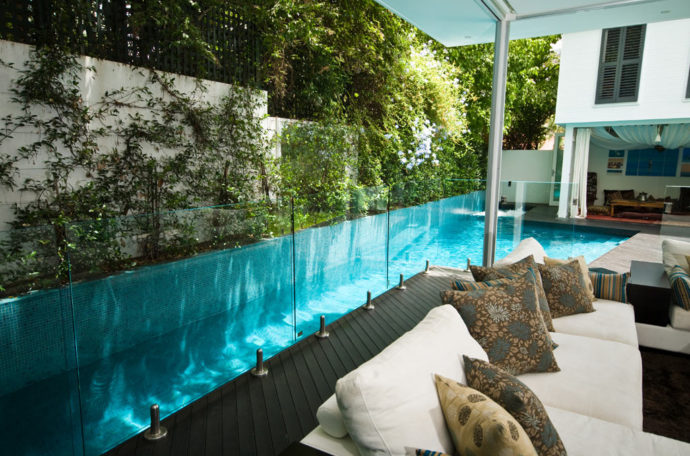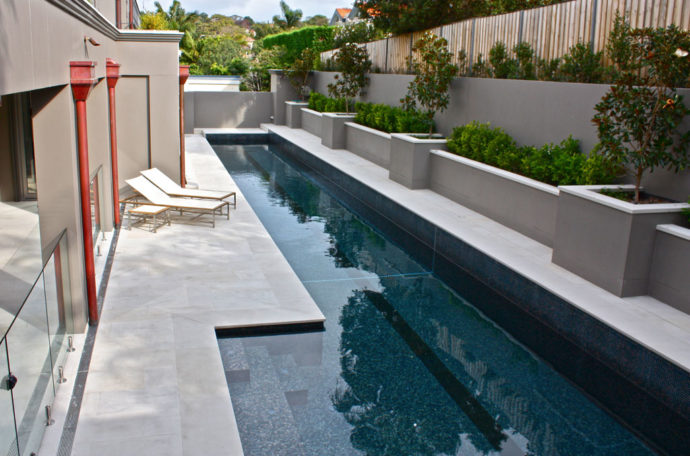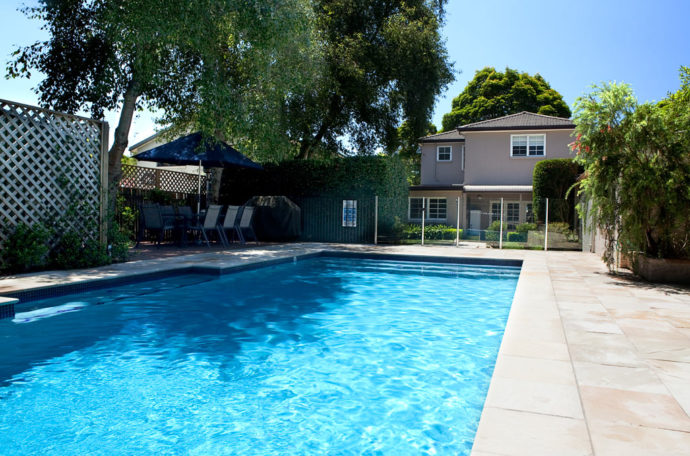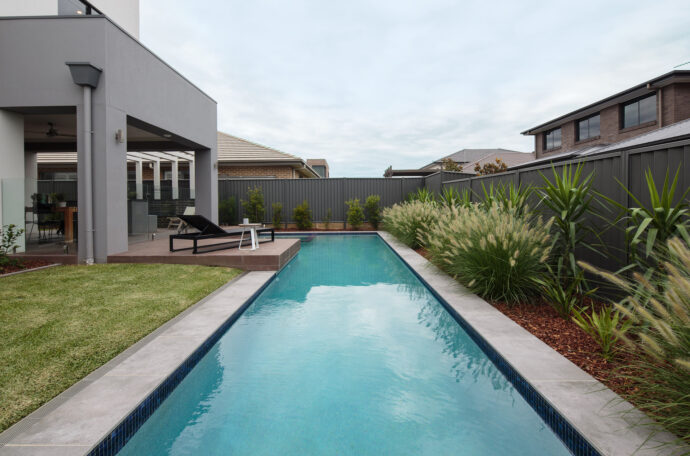It’s an essential question: “where should I position my swimming pool?” It’s a topic our team covers extensively with you during the initial planning and construction stages of installing your inground concrete pool. Working with Crystal Pools, we first offer a complimentary site visit. We’ll come to you and discuss the considerations that will affect your swimming pool placement.
But if you’re just in the beginning stages of looking at getting an inground concrete pool, there are a few things you’ll need to consider.
Where you position your swimming pool affects the water temperature, the appearance and style of your backyard, plus the usability of the space.
1. Swimming pool placement in smaller backyards
The most popular method in a confined space is to position the pool against an existing feature such as the house, fence or other boundaries as this maximises the available yard space. In a small backyard, you can create the illusion of space by positioning the pool along the backyards’ longest span.
If you have decided to put your pool near the boundary of your property you will want to minimise disruption to your neighbours and ‘property protection works’. A good rule of thumb is to position the pool at least 1000mm from the boundary. Homeowners usually choose to landscape within this boundary area to enhance the overall space.
For pools in confined spaces, there is a much greater need to echo the overall style of the adjoining home. Choose materials for the coping, decking and connecting pathways that complement the exterior of your home.
2. Aesthetics and amenity to home
Enjoying a pool is not just about swimming in it. Most pool owners will tell you the time spent gazing at their ‘water view’ is far greater than time spent swimming. Andrew Rothery, Sales Manager at Crystal Pools agrees: “You will spend more time enjoying the view of your pool while you are relaxing and entertaining than you will actually spend swimming in it.”
So whether you have a large or a small backyard, your pool will most likely become the dominant focal point of that aspect. Creating a connection between home and pool happens when materials selection (including plants) and pool placement are ‘by design’. Integrating interior and exterior spaces through hard landscaping (pathways, terracing, outdoor entertaining areas) and soft landscaping elements such as garden beds will enhance and add value to your property.
If you plan on building a pool with a spa, you may want it closer to your outdoor dining area, particularly for the cooler months. Having a hot spa ‘nook’ close to your home is a great way to take advantage of your pool all year round.
3. Safety and council regulations
Making your swimming pool safe for children is critical in your design and positioning. Incidentally, unless your children are already strong swimmers, now might be a good time to start swimming lessons. Whether children are young or teens, you will need, and want, to keep an eye on them when they are swimming so consider locating the pool close to the house to make supervision easier. Locating one side of the pool against a fence or garden also means that young children will be discouraged from running around the pool water perimeter.
Most people are aware of the regulations about the mandatory requirement for child-resistant pool fencing. But it’s best to check with your local council to check if there are any additional local building, zoning or safety regulations that you will need to comply with.
The location of your home and your backyard’s orientation will factor in the ultimate positioning of your pool. But swimming pool safety is rightly a concern for parents and safety must be considered for other ages too. In response to this, plus the other benefits we’re mentioning, swimming pools buyers frequently choose the amenity of their pool being positioned closer to the home. When looking at your swimming pool position it’s important to ask yourself if this is a concern for your family’s age and ability, or if you’re confident that the benefits of your swimming pool being positioned further away from your home outweigh this consideration.
4. Obstacles to easy swimming pool construction
Another consideration we’ll look at when helping you evaluate a potential swimming pool location is obstacles. Sometime hard-to-move obstacles such as stormwater drains, gas, electricity or sewers must be taken into account. To determine where they currently sit you can, or Crystal Pools will, get in touch with your local council to acquire diagrams on your property.
Utilities
You should avoid locating your pool over storm-water drains, gas, electricity, sewers, etc. as this will Increase costs for future repairs for any of these services. If you are unsure about their location, your local council should be able to provide diagrams.
Rock And Trees
Our team has been working in Sydney since 1957, so we’ve built in all suburbs across Sydney. Crystal Pools has an extensive knowledge of the council areas more prone to rocky backyards. From this, we’ll provide excavation solutions that fit best for each suburb.
Whilst overhanging trees provide welcome shade when relaxing poolside, they can also partially shade your swimming pool too and mean you are regularly cleaning up leaves in and around your pool. Tree roots need to be considered so they don’t place pressure on landscaping and plumbing. If there are any large trees on your property or close to the dig site, these may need to be removed prior to construction.
This requires council approval and hiring a qualified tree lopper may an additional cost to be prepared for. Trees can influence the placement options and in some cases be the deciding factor as to where it must be positioned when tree removal is not permitted by your council.
5. Pool placement factors effecting cost efficiency
“As Sydney’s most capable pool company we can and have built practically everywhere. We build pools behind narrow terrace houses, in high rise apartments, underneath existing buildings, even out into Sydney harbour (Yep, we built on the low tide)… on cliff edges and on Sydney’s steepest blocks. It’s just a matter of engineering, when its not a standard excavation of a flat backyard block.”.
Slope
The slope of your block can be a cost factor affecting choices for your swimming pool’s location. With years of experience building on the most challenging blocks, Crystal Pools will work with you to discover where slopes can be corrected and ensure reinforcement of your inground concrete pool, offering stability and structural integrity.
Equipment housing
If space allows, place the equipment closer to the swimming pool. The closer the pump is to the pool, the more efficiently it will operate. The filtering system should be at pool level or lower: placing the system above the level of the pool will put undue pressure on the pump and may cause maintenance difficulties.
Final Thoughts
Determining the swimming pool location is a huge part of most swimming pool installations. While this guide will help get you thinking, there’s no substitute for expert advice in this arena because a multitude of factors can impact; where your inground pool will be located, the size and, at times, even the depth of your swimming pool. Sometimes this can be overwhelming. So even if you’re still just considering installing a swimming pool, chat with experts, friendly experts at Crystal Pools to find out more.
